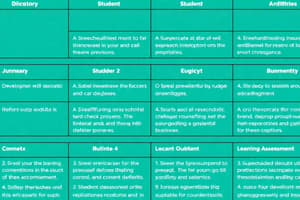Podcast
Questions and Answers
What is a key characteristic of an analytic rubric?
What is a key characteristic of an analytic rubric?
- Focuses only on finished works
- Describes levels of performance for specific criteria (correct)
- Used for broad tasks and skills assessment
- Provides a general assessment of overall performance
Which of the following types of portfolios is designed specifically to showcase a student's best works?
Which of the following types of portfolios is designed specifically to showcase a student's best works?
- Working Portfolio
- Assessment Portfolio
- Process Portfolio
- Showcase Portfolio (correct)
What does a process portfolio primarily document?
What does a process portfolio primarily document?
- The overall learning experience and reflections (correct)
- The tasks and skills covered in class
- A student’s final assessments and grades
- The best works of a student for display
Which element is NOT included in a typical portfolio?
Which element is NOT included in a typical portfolio?
What is a primary purpose of an assessment portfolio?
What is a primary purpose of an assessment portfolio?
Flashcards
Holistic Rubric
Holistic Rubric
A rubric that evaluates a student's overall performance in a general way, providing an overall impression.
Analytic Rubric
Analytic Rubric
A rubric that breaks down a specific skill or task into smaller criteria and assesses performance at each level.
Showcase Portfolio
Showcase Portfolio
A collection of student work designed to display their best work and showcase their skills.
Process Portfolio
Process Portfolio
Signup and view all the flashcards
A Portfolio Includes: Artifacts, Reproductions, Attestation, Productions
A Portfolio Includes: Artifacts, Reproductions, Attestation, Productions
Signup and view all the flashcards
Study Notes
Criteria
- Rubric Types:
- Holistic Rubric: Provides a general overall impression of performance.
- Analytic Rubric: Offers specific criteria for performance levels.
- General Rubric: Assesses broad tasks and skills.
- Task-Specific Rubric: Focuses on specific skills relevant to a given problem.
- Portfolio: A collection of student work.
- Purposeful/Organized: Organized to show student growth or development.
- Portfolio Types:
- Working: Shows development throughout a project.
- Showcase: Highlights the best work.
- Assessment: Used to evaluate achievement (e.g., tests).
- Process: Documents the learning process. Includes evidence and reflections.
- Portfolio Elements:
- Cover Letter
- Table of Contents
- Entries
- Dates
- Drafts
- Reflections
- Core (required)
- Optional (personalized)
Portfolio Contents
- Artifacts: Outputs from the classroom.
- Reproductions: Student work outside the classroom.
- Attestation: Personal notes and teacher evaluations.
- Productions: Student goals, reflections, and captions.
- E-portfolio: Digital collection: essays, posters, photos, videos, art.
Other
- PSGM CAO (Simpson): Includes 6 levels of learning starting from perception and ending with originality;
- Bloom's Taxonomy (Psychomotor): Includes imitation, manipulation, precision, articulation, and naturalization.
- Bloom's Taxonomy (Affective): Includes receiving, responding, valuing, organizing, and internalization.
- Cognitive Domain: Includes remembering, understanding, applying, analyzing, evaluating, and creating. This was also presented as 6 levels in the cognitive domain
- Affective Assessment:
- Semantic Differential Scales: measures opinions using bipolar adjectives
- Likert Scales: uses a 5-point scale measuring the degree of agreement.
- Checklists: Identifies the presence or absence of characteristics or traits.
- Socio Taxonomy (Big + Collis):
- Pre-structural: No knowledge
- Uni-structural: Limited knowledge
- Multi-structural: Several ideas about a concept
- Relational: Concisely presents ideas with connections.
- Extended Abstract: Generates new information.
Studying That Suits You
Use AI to generate personalized quizzes and flashcards to suit your learning preferences.



